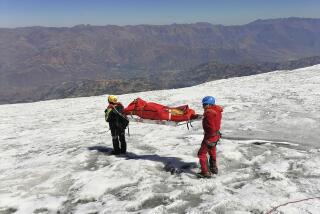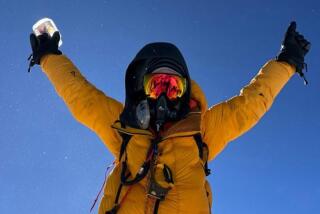Mt. Everest is on the top of this teen’s list
Johnny Strange has trekked across the Nepalese countryside and discovered a mountain range unlike any he had previously set eyes upon.
The Himalayas probe the heavens. Their majesty transcends terms used to describe them. The peaks inspire awe but also reverence and a fear typically reserved for holy places and beings.
Mt. Everest, the preeminent Himalayan giant and world’s tallest landmark, is said by some to possess a soul and unpredictable temperament -- and history, Strange knows, bears this out.
While a few thousand have attained its 29,035-foot summit, thousands more have been denied. Scores remain entombed on the mountain, their frozen bodies revealing themselves, at times, as ghostly reminders of consequences suffered because of missteps, shoddy preparation or plain bad luck.
Thus, it’s understandable that the expedition was met with criticism on the way to base camp.
The 17-year-old from Malibu is aspiring to become the youngest person to conquer the Seven Summits -- the tallest peaks on each continent. He has five in the bag and Everest is his last major hurdle.
Strange also hopes to become the youngest Westerner to conquer Everest. A Nepalese Sherpa, who reached the top at 15, holds the record.
“I’d be lying if I said I wasn’t nervous,” Strange said recently from the Point Dume residence of his father, Brian. “But I like a challenge. The way I see it, within a thousand years we’ll all be gone and the only thing left will be our stories and footsteps. And I plan on having some pretty cool stories.”
Brian Strange, 53, a consumer affairs attorney, and Scott Woolums, the duo’s longtime guide, will be Johnny’s climbing companions.
They are aware of what some critics are saying: The dad is irresponsible for placing his son at such risk. A teenager cannot make proper decisions in a precarious environment where one poor choice can spell disaster. What is the guide thinking?
But Woolums, who is among the world’s most experienced big-mountain guides, said his clients are prepared after expeditions to Antarctica’s Vinson Massif; Russia’s Mt. Elbrus, Argentina’s Mt. Aconcagua, Africa’s Mt. Kilimanjaro and Alaska’s Mt. Denali.
“Surely Johnny has lots to learn,” Woolums wrote in an e-mail from Nepal. “Everyone has a lot to learn. [But] Johnny has learned to respect the mountains he has been on, actually more so than many other climbers I have climbed with.”
Father and son are like-minded adventurers, but have vastly different recollections, philosophies and motivations.
Brian climbs to escape the courtroom and assures that safety is not spared for cost. He paid $150,000 for the Everest expedition, which will include six Sherpa porters who will haul extra oxygen in case an extended high-mountain stay is required.
Brian says his son’s life was not in peril on any previous climb.
But Johnny, in a separate interview, suggests otherwise: “I’ve almost gotten killed so many times. . . . I almost fell into a crevasse while pulling a sled on Denali, and I had to dodge falling rocks on Aconcagua.”
Their odyssey began five years ago in Antarctica. While others Johnny’s age climbed neighborhood trees, the mop-haired 12-year-old, looking comically puny in an oversized extreme-weather suit, clawed his way to the top of 16,023-foot Vinson Massif.
He shattered by nine years the age record and realized, as he gazed across the surreal white landscape, that he’d someday tackle Everest.
“He did it all on his own motivation,” Brian recalled. “I wasn’t sure he’d make it because he had to be roped in and use an ice ax, and the temperature was in the negative 30s. But he did really well.”
During their attempt on 22,840-foot Aconcagua two years ago, Johnny suffered frostbite on his toes, but he and his dad regrouped in a mountain town for two weeks before charging the summit in a remarkably quick 3 1/2 days.
The father paints these adventures as character-building experiences that help his son stay out of trouble in posh environs where partying rich kids routinely get into trouble.
“As ideal as it is living in Malibu, there’s a good and bad element out here, and this just helps keep him grounded and focused,” he said.
Johnny revealed that his motivation stems from a desire to escape the shadow of his two sisters -- Johnny is a middle child -- who are standout students in private schools.
“Everybody always doubts me. Everyone tells me I can’t do this or that,” he said, adding that he wants to take up other extreme pursuits after he turns 18. “No one supports me really, except my parents. People are always telling me, ‘You can’t climb Everest. You’re only 17.’ Just like they told me I couldn’t climb Vinson when I was 12.”
Everest certainly is no theater for children. The notorious Khumbu Icefall, a glacial mass of shifting ice blocks, is a daunting force Strange spoke of with unsettling eagerness.
“Imagine a big ground that opens and shuts and moves all around, and there’s big buildings of ice called seracs that fall randomly, so that’s where most people get killed, and we’re walking right through the belly of it,” he said.
Above 25,000 feet is Everest’s “Death Zone,” where, for extended periods, natural oxygen is too scant to sustain life. Winds can be ferocious and temperatures reach 75-below.
In 2006, 10 climbers perished on Everest’s slopes, the most famous episode involving British climber David Sharp, who was hunkered 1,000 feet below the summit, dying, as about 40 climbers marched past.
Rescue attempts are not always made because the terrain is so precarious and conditions so harsh that many climbers choose to look after only themselves and expedition members.
Most famous was a 1996 chaos-filled catastrophe during which eight climbers, including renowned guides Rob Hall and Scott Fischer, died after a rogue blizzard slammed the mountainside. That was proof that any climber, regardless of experience, can fall victim to Everest’s extremes.
Of the potential dangers, Brian and Johnny are in sync. The father said: “There’s risk every day, and if you’re not willing to take some amount of risk, you’re not going to have an adventure.”
The son, who after Everest would like to take on 7,310-foot Mt. Kosciuszko in Australia, reasoned: “I could focus on all the bad things that could happen, but I like the fact that there’s risk. If there wasn’t any risk, it wouldn’t be fun.”
--
--
latimes.com/sports
Follow along
Strange has already begun to blog about the adventure and will provide periodic updates as long as conditions allow at www.strangeoneverest.com
More to Read
Sign up for The Wild
We’ll help you find the best places to hike, bike and run, as well as the perfect silent spots for meditation and yoga.
You may occasionally receive promotional content from the Los Angeles Times.






